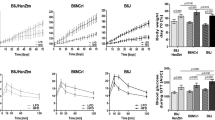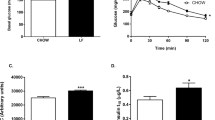Abstract
Background/Objectives:
Obesity is a metabolic disorder that predisposes patients to numerous diseases and has become a major global public-health concern. Animal models of diet-induced obesity (DIO) are frequently used to study obesity, but which DIO model most accurately reflects the pathology of human obesity remains unclear. In this study, we designed a diet based on the human Western diet (WD) and compared it with the cafeteria diet (CAF) and high-fat diet (HFD) in order to evaluate which diet most closely mirrors human obesity.
Methods:
Wistar rats were fed four different diets (WD, CAF, HFD and a low-fat diet) for 18 weeks. Metabolic parameters and gut microbiota changes were then characterized.
Results:
Rats fed the four different diets exhibited completely different phenotypes, highlighting the importance of diet selection. This study also revealed that WD most effectively induced obesity and obesity-related disorders, and thus proved to be a robust model of human obesity. Moreover, WD-fed rats developed obesity and obesity-related comorbidities independent of major alterations in gut microbiota composition (dysbiosis), whereas CAF-fed rats developed the greatest dysbiosis independent of obesity. We also characterized gut microbiota after feeding on these four different diets and identified five genera that might be involved in the pathogenesis of obesity.
Conclusions:
These data suggest that diet, and not the obese state, was the major driving force behind gut microbiota changes. Moreover, the marked dysbiosis observed in CAF-fed rats might have resulted from the presence of several additives present in the CAF diet, or even a lack of essential vitamins and minerals. Based on our findings, we recommend the use of the prototypic WD (designed here) in DIO models. Conversely, CAF could be used to investigate the effects of excessive consumption of industrially produced and highly processed foods, which are characteristic of Western society.
This is a preview of subscription content, access via your institution
Access options
Subscribe to this journal
Receive 12 print issues and online access
$259.00 per year
only $21.58 per issue
Buy this article
- Purchase on Springer Link
- Instant access to full article PDF
Prices may be subject to local taxes which are calculated during checkout





Similar content being viewed by others
References
Haslam DW, James WPT . Obesity. Lancet 2005; 366: 1197–1209.
Smyth S, Heron A . Diabetes and obesity: the twin epidemics. Nat Med 2006; 12: 75–80.
Cordain L, Eaton SB, Sebastian A, Mann N, Lindeberg S, Watkins BA et al. Origins and evolution of the Western diet: health implications for the 21st century. Am J Clin Nutr 2005; 81: 341–354.
National Center for Health Statistics Health, United States, 2015: with special feature on racial and ethnic health disparities. National Center for Health Statistics: Hyattsville, MD, 2016.
Buettner R, Schölmerich J, Bollheimer LC . High-fat diets: modeling the metabolic disorders of human obesity in rodents. Obesity 2007; 15: 798–808.
Nilsson C, Raun K, Yan F, Larsen MO, Tang-Christensen M . Laboratory animals as surrogate models of human obesity. Acta Pharmacol Sin 2012; 33: 173–181.
Sampey BP, Vanhoose AM, Winfield HM, Freemerman AJ, Muehlbauer MJ, Fueger PT et al. Cafeteria diet is a robust model of human metabolic syndrome with liver and adipose inflammation: comparison to high-fat diet. Obesity 2011; 19: 1109–1117.
Higa TS, Spinola AV, Fonseca-Alaniz MH . Evangelista FSA. Comparison between cafeteria and high-fat diets in the induction of metabolic dysfunction in mice. Int J Physiol Pathophysiol Pharmacol 2014; 6: 47–54.
Moore BJ . The cafeteria diet-an inappropriate tool for studies of thermogenesis. J Nutr 1987; 117: 227–231.
Shen J, Obin MS, Zhao L . The gut microbiota, obesity and insulin resistance. Mol Aspects Med 2013; 34: 39–58.
Sonnenburg JL, Bäckhed F . Diet–microbiota interactions as moderators of human metabolism. Nature 2016; 535: 56–64.
Lecomte V, Kaakoush NO, Maloney CA, Raipuria M, Huinao KD, Mitchell HM et al. Changes in gut microbiota in rats fed a high fat diet correlate with obesity-associated metabolic parameters. PLoS One 2015; 10: e0126931.
Boulangé CL, Neves AL, Chilloux J, Nicholson JK, Dumas M-E . Impact of the gut microbiota on inflammation, obesity, and metabolic disease. Genome Med 2016; 8: 42.
National Research Council Guide for the Care and Use of Laboratory Animals. 8th edn. The National Academies Press: Washington, DC, USA, 2011.
Reeves PG, Nielsen FH, Fahey GC . AIN-93 purified diets for laboratory rodents: final report of the American Institute of Nutrition ad hoc writing committee on the reformulation of the AIN-76A rodent diet. J Nutr 1993; 123: 1939–1951.
Grotto D, Zied E . The standard American diet and its relationship to the health status of Americans. Nutr Clin Pract 2010; 25: 603–612.
US Department of Agriculture. Nutrient intakes from food: mean amounts of consumed per individual, by gender and age. What we eat in America. Natl Heal Nutr Exam Surv 2011–2012 2012; 1–9.
Berthoud HR, Zheng H . Modulation of taste responsiveness and food preference by obesity and weight loss. Physiol Behav 2012; 107: 527–532.
Oliveros E, Somers VK, Sochor O, Goel K, Lopez-Jimenez F . The concept of normal weight obesity. Prog Cardiovasc Dis 2014; 56: 426–433.
Thorburn AN, Macia L, Mackay CR . Diet, metabolites, and ‘western-lifestyle’ inflammatory diseases. Immunity 2014; 40: 833–842.
de Macedo IC, de Freitas JS, da Silva Torres IL . The influence of palatable diets in reward system activation: a mini review. Adv Pharmacol Sci 2016; 2016: 1–7.
Bellentani S, Scaglioni F, Marino M, Bedogni G . Epidemiology of non-alcoholic fatty liver disease. Dig Dis 2010; 28: 155–161.
Adams La, Angulo P . Recent concepts in non-alcoholic fatty liver disease. Diabet Med 2005; 22: 1129–1133.
Ouchi N, Parker JL, Lugus JJ, Walsh K . Adipokines in inflammation and metabolic disease. Nat Rev Immunol 2011; 11: 85–97.
Gavrila A, Chan JL, Yiannakouris N, Kontogianni M, Miller LC, Orlova C et al. Serum adiponectin levels are inversely associated with overall and central fat distribution but are not directly regulated by acute fasting or leptin administration in humans: cross-sectional and interventional studies. J Clin Endocrinol Metab 2003; 88: 4823–4831.
Ahmad S, Khan MS, Akhter F, Khan MS, Khan A, Ashraf JM et al. Glycoxidation of biological macromolecules: a critical approach to halt the menace of glycation. Glycobiology 2014; 24: 979–990.
Teodoro JS, Varela AT, Rolo AP, Palmeira CM . High-fat and obesogenic diets: current and future strategies to fight obesity and diabetes. Genes Nutr 2014; 9: 406.
Veteläinen R, van Vliet A, van Gulik TM . Essential pathogenic and metabolic differences in steatosis induced by choline or methione-choline deficient diets in a rat model. J Gastroenterol Hepatol 2007; 22: 1526–1533.
Zeisel SH, da Costa K-A . Choline: an essential nutrient for public health. Nutr Rev 2009; 67: 615–623.
Kucera O . Experimental models of non-alcoholic fatty liver disease in rats. World J Gastroenterol 2014; 20: 8364–8376.
Turnbaugh PJ, Bäckhed F, Fulton L, Gordon JI . Diet-induced obesity is linked to marked but reversible alterations in the mouse distal gut microbiome. Cell Host Microbe 2008; 3: 213–223.
Le Chatelier E, Nielsen T, Qin J, Prifti E, Hildebrand F, Falony G et al. Richness of human gut microbiome correlates with metabolic markers. Nature 2013; 500: 541–546.
DeGruttola AK, Low D, Mizoguchi A, Mizoguchi E . Current understanding of dysbiosis in disease in human and animal models. Inflamm Bowel Dis 2016; 22: 1137–1150.
Rosini TC, Ramos da Silva AS, de Moraes C . Diet-induced obesity: rodent model for the study of obesity-related disorders. Rev Assoc Med Bras 2012; 58: 383–387.
Damms-Machado A, Weser G, Bischoff SC . Micronutrient deficiency in obese subjects undergoing low calorie diet. Nutr J 2012; 11: 34.
Via M . The malnutrition of obesity: micronutrient deficiencies that promote diabetes. ISRN Endocrinol 2012; 2012: 1–8.
Tremaroli V, Bäckhed F . Functional interactions between the gut microbiota and host metabolism. Nature 2012; 489: 242–249.
Wu GD, Chen J, Hoffmann C, Bittinger K, Chen Y-Y, Keilbaugh SA et al. Linking long-term dietary patterns with gut microbial enterotypes. Science 2011; 334: 105–108.
Brown K, DeCoffe D, Molcan E, Gibson DL . Diet-induced dysbiosis of the intestinal microbiota and the effects on immunity and disease. Nutrients 2012; 4: 1095–1119.
Rabot S, Membrez M, Blancher F, Berger B, Moine D, Krause L et al. High fat diet drives obesity regardless the composition of gut microbiota in mice. Sci Rep 2016; 6: 32484.
Reardon S . A mouse’s house may ruin experiments. Nature 2016; 530: 264–264.
Collins FS, Tabak LA . NIH plans to enhance reproducibility. Nature 2014; 505: 612–613.
Casadevall A, Fang FC . Reproducible science. Infect Immun 2010; 78: 4972–4975.
Servick K . Mouse microbes may make scientific studies harder to replicate. Science 2016 doi:10.1126/science.aah7199.
Hariri N, Thibault L . High-fat diet-induced obesity in animal models. Nutr Res Rev 2010; 23: 270–299.
Acknowledgements
Funding for this project was provided by the Brazilian funding agencies CNPq (402471/2013-0), CAPES, FAPERGS (PRONEX 16/2551-0000 499-4) and PROPESQ-UFRGS.
Author information
Authors and Affiliations
Corresponding author
Ethics declarations
Competing interests
The authors declare no conflict of interest.
Additional information
Supplementary Information accompanies this paper on International Journal of Obesity website
Rights and permissions
About this article
Cite this article
Bortolin, R., Vargas, A., Gasparotto, J. et al. A new animal diet based on human Western diet is a robust diet-induced obesity model: comparison to high-fat and cafeteria diets in term of metabolic and gut microbiota disruption. Int J Obes 42, 525–534 (2018). https://doi.org/10.1038/ijo.2017.225
Received:
Revised:
Accepted:
Published:
Issue Date:
DOI: https://doi.org/10.1038/ijo.2017.225
This article is cited by
-
Endogenous Coriobacteriaceae enriched by a high-fat diet promotes colorectal tumorigenesis through the CPT1A-ERK axis
npj Biofilms and Microbiomes (2024)
-
Relevance of Indian Traditional Herbal Brews for Gut Microbiota Balance
Indian Journal of Microbiology (2024)
-
The novel approach for non-invasive diagnostic biomarkers from an early stage of NAFLD to advanced fibrosis
Egyptian Liver Journal (2023)
-
Once a week consumption of Western diet over twelve weeks promotes sustained insulin resistance and non-alcoholic fat liver disease in C57BL/6 J mice
Scientific Reports (2023)
-
Moderate aerobic training is safe and improves glucose intolerance induced by the association of high fat diet and air pollution
Environmental Science and Pollution Research (2023)



